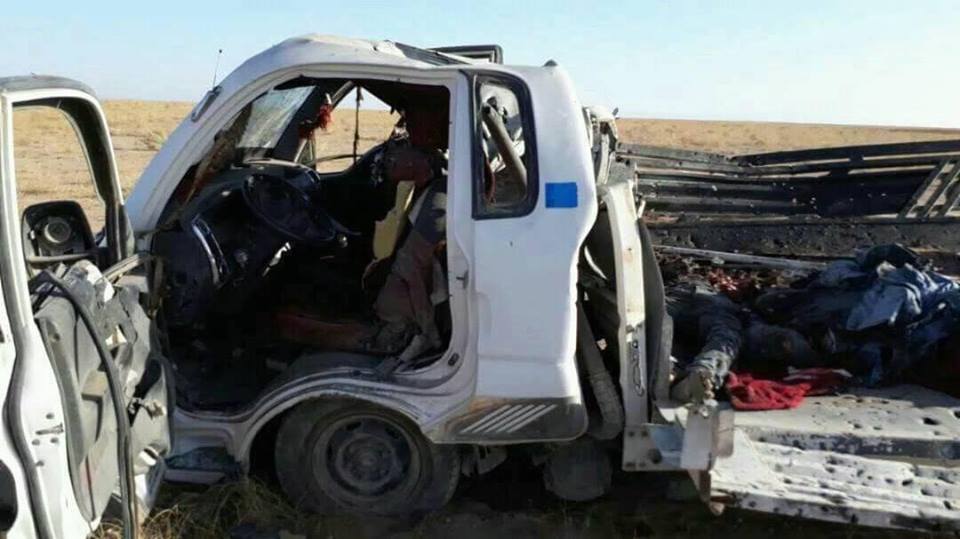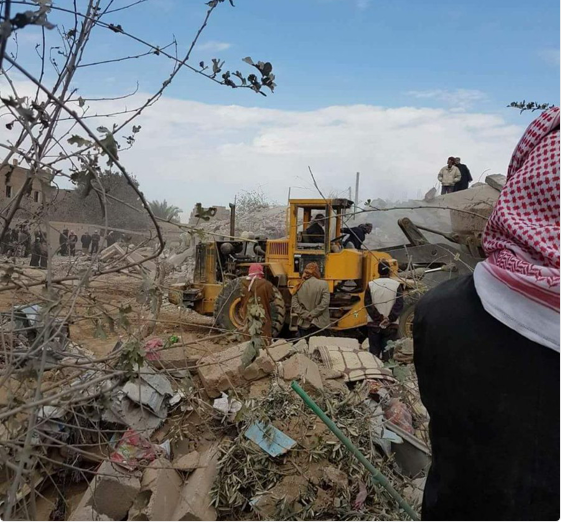Following the capture of almost all territory once controlled by so-called Islamic State (ISIS), Coalition actions in both Iraq and Syria fell precipitously during November. Overall, likely deaths caused by the alliance’s bombs and artillery also fell by more 80% to between 57 and 76 — their lowest levels since September 2016.
With the full liberation of Raqqa in October, minimum likely deaths in Syria fell by 96% to between 12 and 26 civilians. On November 9th, the government of Syria declared victory over ISIS, though Coalition strikes continued in Deir Ezzor governorate, where Aiwars tracked all but one of the 33 monitored claimed events in the country. In Iraq, only one alleged Coalition casualty event was recorded.
Official data for November likewise shows a sharp fall in Coalition actions. Just as civilian deaths rose in lockstep with higher attack rates, so they have fallen as guns go silent. Coalition air and artillery strikes decreased by 68% on October, while the number of munitions dropped – a far more reliable metric of activity than strikes – decreased by 39% to its lowest level since September 2014.
Meanwhile, there was an 8% increase in the number of events tracked which reportedly involving Russia aircraft in Syria. Between 351 and 478 civilians were claimed killed in 96 attacks tied to Russian forces. About two-thirds of these reports were in Deir Ezzor provionce. Our researchers also monitored a worrying 280% rise in casualty events in Idlib governorate compared to October, including several mass casualty events.
The dramatic fall in casualty events allegedly involving the Coalition likely signals the end of Coalition civilian casualties outnumbering those of Russia — a trend that lasted for most of this year. By any measure, 2017 has been the worst year for civilians in the fight against ISIS, as battles moved deep into Iraqi and Syrian cities. Despite the Coalition’s insistence that it was waging “the most precise war in history”, Airwars estimates that at least 3,875 non-combatants have been killed by Coalition actions during 2017 to November. The complete toll in cities like Mosul and Raqqa still remains unknown.
Coalition trends
From 2014 through the end of November 2017, the Coalition had reported 14,102 air and artillery strikes in Iraq, along with 14,357 in Syria. During November, the Coalition declared 85 strikes in Iraq, a decrease of 57% from October. In Syria, 139 strikes were reported, a 72% fall and the lowest number reported since March 2016.
According to official data published by US Air Force Central Command, the Coalition’s officially active members (the US, UK, France, Belgium, Australia and likely Jordan – along with possibly Saudi Arabia and the UAE) released a total of 1,000 munitions during air raids on ISIS targets in Syria across Iraq and Syria. This was a 39% decrease from November, bringing bombs and missiles dropped to the lowest level since September 2014.
Actions by the UK and France, the US’s two main allies, continued to fall during November. The British Ministry of Defense reported just nine strikes in Iraq, an 18% drop on the previous month. In Syria only six strikes were reported by the UK, a fall of 73% from October. France also reported just nine strikes in Iraq and no actions at all in Syria.
Military developments
Following the liberation of Raqqa from ISIS on October 20th, local media reported that on November 5th – after six months as IDPs – civilians began returning to the city’s al Mashlab neighbourhood. A followup report said that every person had to confirm in writing to the SDF that they were returning voluntarily to their own home and would take full responsibility for what occurred.
While civilians may finally be out of harm’s way of ISIS attacks and air and artillery strikes, reports emerged of a major legacy problem of unexploded ordnance in Raqqah – from ISIS booby traps and mines, to unexploded Coalition munitions.
ISIS’s territory continued to shrink elsewhere, and it was all but eradicated as a territorial entity in both Iraq and Syria. On November 4th, the Coalition announced that Iraqi forces had seized the key border area of al Qaim in Iraq.
The simultaenous assaults on Al Qaim and the town of Deir Ezzor in eastern Syria meant that only Abu Kamal, on the Syria side of the border, remained as the final major town under full ISIS control.
On November 9th, the government of Syria declared victory over ISIS, though Coalition air and artillery strikes continued in Deir Ezzor governorate throughout the remainder of November.
However, as the end of ISIS’s caliphate neared, reports indicated that the terrorist group had switched tactics and reverted to insurgency mode, possibly explaining the sudden collapse of the group in areas in which the Coalition had expected to fight harder for a final defeat.

A French Air Force Dassault Rafael conducts air strikes and patrols in Iraqi and Syrian airspace in support of Operation Inherent Resolve, Nov. 22, 2017. (via U.S. Air Force)
Coalition civilian casualties
With the war against ISIS now in its final stage, Airwars monitored an 81% fall in deaths likely caused by the US-led Coalition during November. This brought likely fatalities to their lowest reported level since October 2016.
Airwars researchers tracked a total of 34 claimed civilian casualty events across Iraq and Syria – a 62% fall on the 90 events tracked during October. All but one of these 34 events occurred in Syria.
Of these 34 events, Airwars currently assess just five as having likely resulted from Coalition actions (four in Syria and one in Iraq) – an 87% decrease on the 39 ‘fair’ events’ tracked in October. A ‘fair’ categorization means that an event has two or more uncontested sources, and that the Coalition has confirmed carrying out strikes on the same day in the vicinity.
Across the five events, Airwars currently assess that between 57 and 76 civilians were likely killed by Coalition strikes, compared to a minimum of 304 in October.
The raw, unvetted number of alleged deaths from all Airwars monitoring of Coalition actions during October in Iraq and Syria – across all incidents assessed as ‘fair’, ‘poor’ ‘contested’ and ‘discounted’ – currently stands at between 183 and 256 claimed civilian fatalities.
Syria: likely deaths fall by 96%
Deaths assessed as likely caused by the Coalition in Syria fell dramatically after Raqqa fell to Syrian Democratic Forces on October 20th: their lowest levels in over a year. During November, Airwars tracked 33 alleged Coalition civilian casualty events across Syria – a 60% fall on October. But of these 33 events, just four were assessed as likely carried out by the US-led Coalition, compared to 38 likely events in October.
Across those four casualty events, Airwars currently estimates that between 12 and 26 civilians died – a massive decrease from the minimum of 284 casualties tracked by Airwars researchers during October. The assessed toll in November is the the lowest in Syria in any one month since August 2016.
The overall, unvetted toll for Syria across all categories – ‘fair’, ‘weak’, ‘contested’ and ‘discounted’ – was between 138 and 206 civilians killed.
Local monitors have shown similar trends. Raqqa is Being Slaughtered Silently monitored 312 deaths reportedly caused by the Coalition in October and in November they reported none.
With ISIS now defeated in Raqqah, Airwars tracked no civilian deaths in the governorate during November. Airwars currently estimates that at least 1,450 civilians died in Raqqah as a result of Coalition actions from the beginning of June until the end of October. The Coalition, however, has so far conceded only only 15 civilian deaths within Raqqah from the start of the assault.
Those civilians still in the devastated city remained at risk. According to Raqqa is Being Slaughtered Silently, 87 non-combatants were killed in explosions of landmines planted by ISIS before their defeat. On November 30th, Medecins San Frontieres reported that residents returning to Raqqah in the aftermath of the fighting were finding not only their homes destroyed, but the surrounding streets and fields littered with explosives.
Allegations shifted to Deir Ezzor governorate, where all but one of the reported Coalition casualty events tracked by Airwars occured. Many more events, however, were contested, with most allegations shared between the regime, Iraqi forces, Russia and the Coalition.
“What has been interesting to see is that many monitors are not even trying to identify the planes that carry out the raids,” says Kinda Haddad, head of the Airwars Syria team. “The reports refer to them simply as ‘warplanes’. For example, the Syrian Observatory for Human Rights documented the deaths of 230 Syrian civilians in Deir Ezzor between November 8th and December 1st in shelling ‘by the regime, the Iraqi Mobilization forces, Russia and the international Coalition’.” In cases like this, Airwars cannot make a clear assessment. Airwars currently assesses that between 125 and 178 civilians died across 27 events graded as contested throughout November.
Footage of a strike on the town of Hajeen, Deir Ezzor, Nov 2nd. Like many reports during the month, the source referred only to “warplanes”.
Nevertheless, there were still three significant events which could likely be attributed to the US-led Coalition.
On November 4th, six civilians including one woman reportedly died in an alleged Coalition airstrike on Al Basira in Deir Ezzor, according to local media. Al Hasaka Arabea News reported the death of Mohammad Manadi al Sha’ara known as Baj’eeb, saying that he died “in front on of the Grand Mosque in Al-Basira”. Additional victims were named as Ahmed Mahmoud Hassan al-Abd known as Tahmir Abu Jakouk, Abdul Qadir Talib Daoud Al-Hassan Al-Ali, Mustafa Nuri Ahmed al Douda, Abdulmutallab Dawood Al Hussein (an engineer) and Ms. Reham Ismail Hamadi Al-Obeid. The Syrian Network for Human Rights, Almanar and Radio Alkul all blamed the Coalition.
The two bloodiest events over the month both occured on November 11th. The first was tracked in Al Duaij Tel-Shayer, in Hasaka governorate, where local media reported that up to 15 civilians died in an alleged Coalition airstrike. According to Al Khabour, the Coalition struck a civilian car killing one non-combatant and wounding several others. More detail was given by the Syria Press Center, which claimed that Al-Duaij was “subjected to air raids from Coalition aircraft” resulting in the death of 15 people from the family of Al-Sinjar and Al-Azzou. Hasaka Rasd named victims as the “children of Majid al-Sinjar and children of Fadel Al-Azzou“. The Step News Agency also put the death toll at 15.

‘Pictures showing the remains of civilians scattered by the bombing of international coalition aircraft for a civilian car near the village of # Duaij of the town of # Tal_Shayer east of Al-Shaddadi’ , Nov 11th (via Hasaka Rasd)
A further five civilians including paramedics were killed, and many more reportedly wounded in an alleged Coalition airstrike the same day on an ambulance in Rajim al Salibi. Local media cited sources who said that the victims died as they attempted to help those wounded in the earlier casualty event in Al Duaij. Zaman al Wasl was among sources blaming the Coalition reporting that “the car, which helped [the wounded] to cross the Al Salibi crossing was targeted again by a drone plane and so far no one has been able to reach to the bodies”.
The victims were reportedly struck as paramedics attempted to transport them from Al Duaji to receive medical attention in Rajim Al-Salibi. Baladi, also attributing the event to the Coalition, added that “three paramedics and two drivers” died in the incident. Victims were named by Al Khabour as Fadel Al-Ezzo, Bader Fadhal Al-Ezzo, Abdul Majid Alsnagar, Abdul Ghafur and Abdul Majid Al-Sinjar (Omar Aldolf).
Iraq: just one event tracked during the month
During November, Airwars tracked just one civilian casualty event in Iraq linked to reported Coalition actions. It occurred in Al Qaim in Anbar province on November 1st, and Airwars presently asssesses the event as likely having resulted from a Coalition action.
According to Omar Al Halbusi, Coalition strikes killed 45 civilians and wounded dozens more. The alleged air and artillery bombing was also reported by Yaqein, which referred to the “indiscriminate shelling of residential areas” in the centre of Al Qaim. The source put the death toll at between 45 and 50 non-combatants, but didn’t identify the party responsible. Another source, The Association of Muslim Scholars in Iraq, also claimed that 45 civilians died with dozens more wounded.
On the same day, the Coalition reported that iut had conducted actions in the vicinity, noting that ” Near Al Qaim, one strike engaged an ISIS tactical unit, destroying two ISIS vehicles and an encampment.”

Iraqi Security Forces conduct rocket strikes against ISIS near Rawa, Iraq, Nov. 17, 2017 (via U.S. Army)
Russian military actions and civilian casualties
Airwars researchers tracked 96 casualty events reportedly involving Russian aircraft in Syria during November – an 8% increase from the 89 events tracked during October.
Across those events, between 351 and 478 civilians were reported killed in alleged Russian actions. These numbers are raw and based only on initial monitoring. They are at present unvetted, and therefore should not be directly compared to the Coalition estimates published in this report.

Ahmed Naoum al-Nakheel, killed in an airstrike on Sayyal, Nov 1st. Sources were conflicted as to whether the Coalition, the Iraqi AIr Force or Russia were to blame (via Euphrates Post)
As in October, the majority (65%) of allegations against Russia occurred in Deir Ezzor governorate (now also the site of most Coalition allegations). However, November also saw a significant uptick in claimed Russian events reported in Idlib governorate. Airwars researchers tracked 19 such events there – a 280% increase over what was monitored in October.
“While most of the incidents in October were carried out primarily in Deir Ezzor, we have noticed a rise in the number of airstrikes in Northern Syria in November, especially in Idlib,” says Abdulwahab Tahhan, an Airwars researcher who monitors reported Russian strikes in Syria. “On November 13th, an alleged Russia airstrike in a residential area and a local market in Atareb, Idlib killed between 67 and 82 civilians, according to sources on the ground. The scenes from the incidents were very graphic and horrific to watch, and it was reported that up to 340 civilians were also injured. Many men, women and children were buried under the rubble.”

Image tweeted by @7UFCmSxd0IUBffH which shows the aftermath of an alleged Russian strike on the town of Al-Sha’fa, Nov 26th.
On November 26th, there was another major casualty event in al Sha’afa, Deir Ezzor. Local sources reported that up to 65 civilians including 21 children and nine women died when several civilian homes and the Al-Fandi Commercial Complex were struck. Almost all sources blamed Russia, though the Russian Ministry of Defence later explicitly denied responsibility. One source – Zamanalwasl – alleged that the Coalition (and bizarrely Egypt) were to blame. Airwars has so far published the names of 42 victims.
The sharp fall in reported Coalition casualty events in both Iraq and Syria appears to mark the end of a trend that characterized much of 2017 — with US-led strikes reportedly killing more civilians than Moscow’s own campaign in support of the Assad government.
Airwars Iraq and Syria analysis: Kinda Haddad, Salim Habib, Abdulwahab Tahhan, Shihab Halep, Koen Kluessien, Christiaan Triebert, Oliver Imhof, Poppy Bowers, Eeva Sarlin, Samuel Oakford, Sophie Dyer, Laura Bruun, and Chris Woods.
